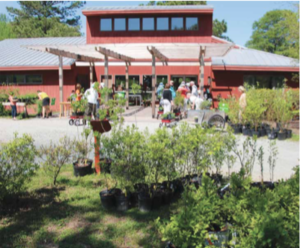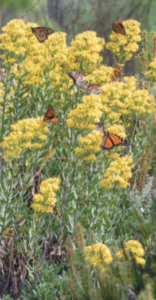Native attraction
Fall a good time for habitat-boosting plants

If all planting or planting natives plants appeals to you but you aren’t sure how or what to add to your landscape, fear not. You are just in time for fall native plant sales that dot the Mid-Shore.
(Photo courtesy Adkins Arboretum)
Even if your summer garden wore you out this year, don’t trade in your garden gloves for mittens quite yet.
Fall is a great time to extend your planting, and native plants are terrific for taking you (and the birds, bees and butterflies) from the summer greens to past the Christmas evergreens.
While your summer garden can be tricky and maintenance can be time consuming, natives are great year round as they take naturally to the surrounding environment and require little soil amending, watering, pest control and other upkeep from you.
Have you ever noticed that when you walk around parks focused on native plants such as Adkins Arboretum in Ridgely that the woods are never really bare?
Close to every month of the year, there is something coming to life as something else is fading for the season.
Luckily for you and the wildlife that also calls your property their home, you are just in time for Fall Native Plant sales that dot the Mid- Shore.
If fall planting or planting natives plants appeals to you but you aren’t sure how or what to add to your landscape, fear not.
Adkins Arboretum will have its Fall Plant Open House Sept. 8-10, with Samantha Pitts, an Educator from Pickering Creek speaking on bird habitats on Friday, Sept. 8, and Chris Pax, the Native Landscape Designer of Adkins Arboretum, speaking on featured native plants on Saturday, Sept. 9 at 11 am.
Environmental Concern, Inc. will also be hosting their Native Plant Sale on Sept. 8-9, with lectures on Monarch Rearing on Friday, Sept. 8 at 10 am and Late Season Nectar Sources for Monarchs” on Saturday Sept. 9 at 10 am.
By planting natives, you will be impacting a helpless animal’s life without even pledging $0.36 a day or receiving a free tote bag.
Monarchs
In the spring it seems everyone is thinking about providing plants and food sources for fluttering butterflies, buzzing bees, and

Adding natives such as goldenrods as nectar sources can help Monarch butterflies stay nourished as they journey to warmer weather.
the like.
But the truth is, migrating animals aren’t like the human traffic that clogs up Routes 404 and 50 that tends to taper off by the end of summer.
Migrators may be starting their journey as late as September or October, when summer plants are coming to an end.
Where do these travelers go? Monarchs migrate to Mexico for a winter fiesta, a trek that can sometimes require them to travel thousands of miles.
As the weather warms again, a future generation will head back to the Mid-Atlantic region.
While certain cultivars of milkweed are a favorite amongst gardeners to attract Monarchs in the spring, plants only hang around until August.
Adding natives such as Asters and Goldenrods as nectar sources can help the Monarchs stay nourished as they journey to warmer weather.
How do we know our Eastern Shore Monarchs are the same ones that appear in Mexico? Parks and other organizations across the country, including Pickering Creek in Easton, participate in a nationwide Monarch tagging program that helps track the butterffies in a database as they make their journey.
On Sept. 13 or 20 at Pickering Creek at 4:30 pm, you can observe the process and learn more about building a Monarch friendly habitat with native plants and other resources.
Environmental Concern Inc. in St. Michaels also hosts a variety of Monarch centered education classes throughout the year as part of the Mid-Atlantic Monarch Initiative.
Planting native nectar sources will also help keep honeybee colonies stronger through the winter and help them produce more honey to store.
Birds
Aside from helping migrating critters, native plants can also be food for the wildlife that isn’t leaving for the cold weather.
Winterberry, a native shrub, looks beautiful and seasonal as its bright red berries stand out against a cooler weather landscape but it is also very valuable as the harshness of winter starts to set in.
As an “emergency food source,” the berries help creatures great and small from robins to deer to mice sustain themselves through the winter (though they are toxic to some domestic animals).
Some believe that since they are so bitter until fully ripened, they are often left alone until all other food sources are depleted, hence the emergency title.
Even native plants that are thought to be “for spring” can be really beneficial in the fall and winter as well. The Dogwood tree is one such example.
“I really like to think of the Dogwood tree as the ‘giving tree’ as one tree can provide for more than 100 species of moths and butterflies,” says Robyn Affron, Volunteer Coordinator at Adkins Arboretum.
Look for plants that will provide fruit, nut, or seed in the late fall to winter.
For those varieties, you’ll want to forgo trimming back your plants to the end of winter or early spring as when they produce or go to seed, they’ll offer a natural seed for hungry animals to nibble on and spread.
Besides being food sources, fall plants offer coverage and warmth to animals when other vegetation dwindles down and leaves non-hibernating animals out in the elements.
Should plants be native to provide for creatures? Dr. Tallamy of the University of Delaware, estimates that foreign ornamentals provide for 29 times less than native plants.
Doing Good Can Look Good
Some folks shy away from native plants as they think they are too plain or boring, but that’s far from true, native plant proponents say, as they add just as much interest and beauty as ornamental plants.
Natives come in several sizes, shapes and textures and mixing a few varieties will add a design element and also go to help those aforementioned critters.
Planting multiple nectar sources for example, is a good practice should a plant you are using as a food source have an off year.
For color, look at plants such as Shenandoah Switchgrass which has burgundy blades and pinkish ower spikes.
There are several plants that can add rich yellows and reds into your yardscape.
Fall also is a good time to get any deciduous shrubs and plants in the ground.
While they won’t look too impressive above ground, below ground their root base will be getting a head start in getting established to create a stronger plant in the spring.
Get Started!
As more land is developed in the Mid-Shore counties, horticulturists say it is more important than ever for gardeners and homeowners to incorporate native plants into their yards to create a continuous food web for wildlife.



